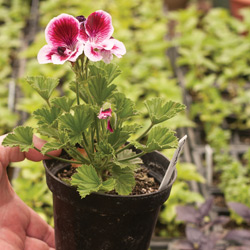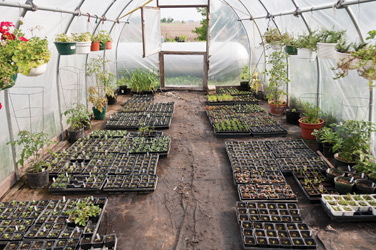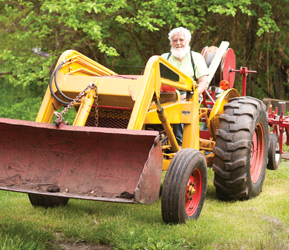As prices at the supermarket rise and more focus is placed on organic and all-natural, there seems to be a resurgence in the “Grow Your Own” movement. While most gardens focus on fruits and vegetables, home growers are adding herbs to their plots as well. “I see a lot of people between the ages of 25 and 40 who are really beginning to get into this ‘safe food’ idea,” reported Caroline Schertz of Green Acres Herb Farm in Lowpoint, Illinois. “They want to be able to grow their own food, as well as their own herbs to flavor it with.”
Not only does growing your own herbs save money, it allows growers control over what goes into their food, and specifically, whether pesticides or fertilizers are used. As with homegrown vegetables, garden-grown herbs significantly reduce the amount of time between cutting and serving, producing a fresher, tastier product. Not to mention, it’s more convenient than making a trip to the store every time you need some fresh basil for that pesto, or cilantro for that salsa.
 Robust Flavors
Robust Flavors
Kris Plunkett, secretary of the Peoria Herb Guild, notes that there are many uses for herbs, but most Guild members are interested in their culinary properties. Schertz, too, said that her average customer is looking for well-flavored culinary herbs.
When starting an herb garden, the first step is to research the herbs you want to grow, and their ability to grow in our central Illinois climate. Another key detail is whether the herbs are annuals, meaning they need to be replanted each year; perennials, which go to seed, survive the winter, and come back on their own year after year; or biennials, which grow during the first year, flower in the second, and then die.
Basil and cilantro are among the most popular annuals grown around here. Oregano, sage and mint are popular perennials that don’t require much attention. Parsley is a biennial, but, according to Schertz, it’s treated like an annual in central Illinois because of our cold winters. Rosemary, technically a perennial, is often treated the same way. Some growers keep rosemary, deemed a “tender perennial,” in a pot indoors, successfully caring for it over the winter months, but others don’t have much luck with this. Some varieties of thyme are tender perennials like rosemary, while others thrive as outdoor perennials in this region.
While it’s possible to grow herbs from seed, many are touchy about germination, so it’s usually more productive for home growers to start their gardens with already-established plants. “For instance,” Schertz said, “rosemary seed, if you just buy the seed in the garden center, under the best conditions, only has 15-percent germination, so we propagate it by cuttings.” This also ensures that the grower knows exactly which variety of rosemary he or she will end up with when the plant starts producing.
Plunkett noted that many herbs thrive in poor soil and don’t need to be fertilized. That’s why herbs often flourish in containers, as long as there’s a drainage hole that allows excess water to escape. This method also makes it easier to winter any tender perennials indoors.
On the other hand, Schertz grows her herbs in a balanced mix of topsoil, vermiculite—a soil additive used to increase moisture retention—and composted manure. Her natural approach ensures the plants get the nutrients they need while adhering to the rules of the USDA’s National Organic Program. While the farm hasn’t applied for certification, its customers know that it’s safe to taste herbs at Green Acres before buying. “People like to be able to taste the herb and make sure it’s the one they remember from their childhood,” Schertz said.
In general, the growing season in central Illinois runs from May to July, although this can vary with the herb. The more you cut herbs, Plunkett reported, the more they’ll grow. One thing to avoid, though, is allowing them to bolt, or flower. When this happens, the plant puts most of its energy into generating the flowers and less into its leaves, which contain the oils and flavors. Once herbs go to seed, they tend to be done for the season. To prevent this, cut your herbs often and pinch off any flowers that begin to form.
Those who grow large crops of herbs during the summer months may want to dry and store their surplus for the winter. The simplest way to do this is to take a bunch of cuttings and let them air-dry, although they can also be dried in the microwave or in countertop dehydrators. Once they are completely dry, the herbs should be stored in a cool, dark place. They will remain flavorful for six to 18 months, depending on how well they’re cared for. “In other words,” Schertz mused, “that bottle of dried parsley you got as a wedding present 15 years ago is practically tasteless by now.”
 Curative Powers
Curative Powers
While most people are interested in herbs for their culinary properties, some like to grow them for their natural curative powers. Herbs have been used for medicinal purposes for thousands of years, and some continue the tradition today. Schertz’ farm sells about 70 different varieties of medicinal herbs.
Achillea, or yarrow, is a popular herbal remedy for influenza, colds and fevers. It’s purported to both slow and increase blood flow, and is used as an anti-inflammatory, antiseptic and astringent. Echinacea is another widely grown medicinal herb, commonly used to ward off colds and help the body recover from them more quickly. It is also used as an analgesic and antibacterial.
Deriving its name from the Latin word meaning “fever reducer,” feverfew has long been used to treat fevers. These days, however, the herb is more commonly used to treat migraines, rheumatism and arthritis. St. John’s wort has become known as an herbal remedy for depression, and it has been used to treat mental disorders for centuries. It has also been used to treat anxiety and sleep disorders, and ease the discomfort of wounds, burns and insect bites.
Natural Dyes
Still others grow herbs for the colors they produce. Native Americans are known for the richly colored fabrics made using herbal dye baths. By soaking the herbs in water, colors emerge that can be used to stain fabric, wool that can be spun into yarn, and reeds that can be woven into baskets. This method is used to this day, and people with hobbies like weaving and spinning often maintain their own gardens of dye herbs, which they use to create colorful materials for their crafts.
While neither Plunkett nor Schertz were very familiar with dye herbs, Plunkett noted that one of the Guild’s members planted woad in the Luthy Herb Garden last year. The biennial, which didn’t spring up until this year, is now about five feet tall. It produces a brilliant blue color. In addition to its medicinal properties, St. John’s wort can be used to create a red dye. Yarrow is another herb used both for its medicinal and dyeing properties; it offers a yellow tint.
Varied Colors & Textures
Some herbs are grown simply for their looks. Most are green, and only green; others come in a variety of colors and textures and can be used as accents in any plot, whether amidst flowers and vegetables or as borders and ground cover. Purple basil, scented geraniums, English lavender and chamomile are a few that thrive in Illinois gardens. Some common herbs, like sage and oregano, even come in colored or variegated varieties.
Whether you’re seeking robust flavors, natural remedies or brilliant colors, an herb garden could be the answer. For help in determining which herbs will work best in your garden, give Green Acres Herb Farm or the Peoria Herb Guild a call. a&s
 Green Acres Herb Farm is located at 1675 County Rd. 1200E in Lowpoint, Illinois, between Metamora and Washburn. It was started 22 years ago by Caroline and Donald Schertz, who run it to this day. Open to the public from 10am to 5pm, Tuesdays through Saturdays from May to October, the farm offers more than 400 varieties of herbs and some heirloom vegetables. You can also find them at the Peoria Riverfront Farmers’ Market and Downtown Bloomington Market on Saturday mornings, and at the Downtown Normal Market on Tuesday evenings throughout the summer. For more information, call (309) 657-6213.
Green Acres Herb Farm is located at 1675 County Rd. 1200E in Lowpoint, Illinois, between Metamora and Washburn. It was started 22 years ago by Caroline and Donald Schertz, who run it to this day. Open to the public from 10am to 5pm, Tuesdays through Saturdays from May to October, the farm offers more than 400 varieties of herbs and some heirloom vegetables. You can also find them at the Peoria Riverfront Farmers’ Market and Downtown Bloomington Market on Saturday mornings, and at the Downtown Normal Market on Tuesday evenings throughout the summer. For more information, call (309) 657-6213.
The Peoria Herb Guild has been teaching central Illinoisans about herbs for three decades. The Guild tends herb gardens at Luthy Botanical Garden and St. Paul’s Episcopal Cathedral in Peoria, brings in speakers who touch on all aspects of using and growing herbs, and often hosts workshops and trips. Their monthly meetings take place at St. Paul’s. For more information, visit peoriaherbguild.org or call (309) 382-1067.


